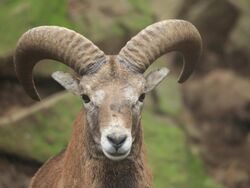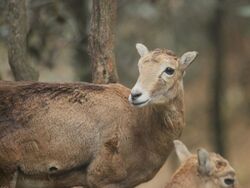Biology:Cyprus mouflon
| Ovis gmelini ophion | |
|---|---|

| |
| Scientific classification | |
| Domain: | Eukaryota |
| Kingdom: | Animalia |
| Phylum: | Chordata |
| Class: | Mammalia |
| Order: | Artiodactyla |
| Family: | Bovidae |
| Subfamily: | Caprinae |
| Tribe: | Caprini |
| Genus: | Ovis |
| Species: | |
| Subspecies: | O. g. ophion
|
| Trinomial name | |
| Ovis gmelini ophion Blyth, 1841
| |
The Cyprus mouflon (Ovis gmelini ophion), also known as Cypriot mouflon, is an endangered subspecies of mouflon endemic only to Cyprus in the mountains of Paphos District.[1] It is the largest animal on the island and due to its uniqueness and rarity it is the national animal of Cyprus.[2]
History
It is believed to be the wild descendant of sheep brought introduced in the island from Asia by the Eteocypriots peopleduring the Neolithic period. Roman archeology discovered from Cyprus have shown depictions of the mouflon on mosaics and frescoes.[citation needed]
It was nearly driven to extinction during the 20th century. In 1997, about 1,200 individuals were counted. The television show Born to Explore with Richard Wiese reported 3,000 individuals on Cyprus.[citation needed]
Etymology
It is also called agrino in the island from the Greek word (Αγρινό). The scientific name was proposed by Edward Blyth in 1841 for wild sheep in the Middle East.[3] In recent years its scientific name was changed after more in depth study.[citation needed]
Description
Cypriot mouflon have short hair, reddish to dark brown colour with dark black stripes on saddle area. Males have horns and females are usually without horns. In mature mouflons the horns are actually almost fully curled into a circle.[citation needed]
The males can weight up to 50 kg and the females around 35 kg.[4]
Their coat in winter becomes heavy and dense while in summer the coat changes and becomes lighter in thickness and colour so that they can cope with the heat.[citation needed]
Behavior
The Cypriot mouflon is a very cautious, shy and agile animal and is not easily approached by humans.[5] They move very fast on the steep slopes of the and are very difficult to approach,especially when they are frightened. The males tend to stay alone. The female gives birth in April and May and usually either one or two lambs are born. They tend to live in small herds.[citation needed]
References
- ↑ "Cyprus mouflon a threatened_species". https://www.researchgate.net/publication/259740139_The_Cyprus_mouflon_a_threatened_species_in_a_biodiversity_hotspot_area.
- ↑ Rehan, Mahmood (2023-08-21). "Exploring the Cyprus National Animal" (in en-US). https://nationalopedia.com/exploring-the-cyprus-national-animal/.
- ↑ (in English) Annals and magazine of natural history : including zoology, botany and geology. London Natural History Museum Library. London. 1841. http://archive.org/details/annalsmagazineof07lond.
- ↑ iakovos-ioannou@outlook.com (2021-01-16). "The Cypriot Mouflon | Cyprus Passion" (in en-US). https://cypruspassion.net/the-cypriot-mouflon/,%20https://cypruspassion.net/the-cypriot-mouflon/.
- ↑ "A unique rare mammal that is found only in Cyprus". https://www.cyprusalive.com/en/cyprus-mouflon-ovis-orientalis-ophion.
Wikidata ☰ Q867506 entry
 |



